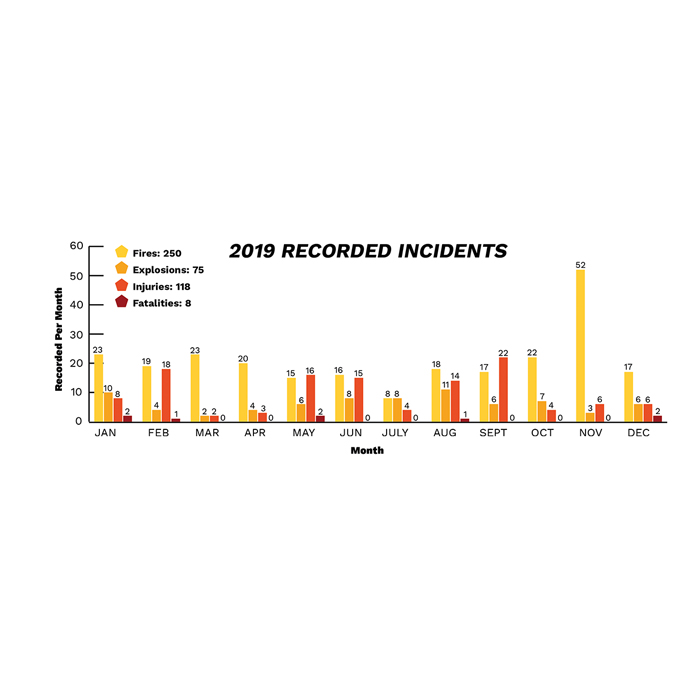Combustible dust hazards are being given more attention, thanks to the NFPA 652 mandate that all industrial facilities complete a dust hazard analysis by September 7, 2020. This emphasis on process safety in industries handling combustible dust suggests that a crisis did not exist until recently, when fire and explosion reports across the globe indicate otherwise.
Dust Safety Science, which has been recording dust-related incidents since 2016, publishes a yearly Combustible Dust Incident Report that reviews loss history, materials and equipment involved, industries affected, and known causes. The 2019 report highlighted the following statistics:
87% of fatalities in the incident database were caused by dust explosions.
73% of injuries were caused by explosions and 27% by fires
Four incidents (three in the U.S. and one in Canada) resulted in over one million dollars in losses.
Food and wood products made up over 65% of the dust fires and explosions. They also resulted in 59% of the injuries and 62% of the fatalities.
If a dust hazard analysis identifies one or more dangerous conditions, NFPA 652 and NFPA 654 provides extensive guidance on how to respond. Recommended measures include:
Using dust collection systems, filters, and ducting to capture and contain dust
Minimizing fugitive dust emissions from manufacturing processes
Regular inspection of false ceilings, joists, and other hidden areas where dust can accumulate
Housekeeping standards that reduce dust build-up
Using specially rated cleaning equipment (e.g., vacuum cleaners certified for Class II, Division 2 or Class I-II, Division 1 areas)
Dust collection systems are the main resource for dust control. There are different types available, including baghouses, cartridge dust collectors, and cyclones. While they can do an effective job of keeping dust hazards under control, they are not a ‘set it and forget it’ solution. In fact, failure to carry out regular inspections and routine maintenance can significantly increase the risk of a combustible dust incident.
Safe operation and maintenance of dust collection systems
According to the Dust Safety Science 2019 report, dust collectors accounted for the highest number of equipment-related incidents last year, with 59 fires and 12 explosions reported. Two incidents cost the facility owners millions in property damage:
On January 3, a fire started in the dust collector of a lumber yard near Pembroke, Ontario. The unit collapsed onto a hydro transformer and interrupted electrical service in the city. After the fire was put out, hydro crews had to restore power to nearly 3,000 homes in Pembroke. Property damage was estimated to be worth millions of dollars.
On June 21, a dust explosion at an ethanol plant in Cloverdale, Indiana, injured two truck drivers and caused property damage estimated at $1 million. Firefighters found a smoldering fire in the dust collector.
The following steps can help keep a dust collector in good working order:
Ensure that the hopper is free of dust buildup. Any accumulation can clog the system, impact performance, and create a fire or deflagration risk.
Inspect the ductwork regularly to avoid dust buildup and accumulation.
Follow NFPA guidelines for dust collector fire, deflagration and explosion protection requirements (e.g, NFPA 652 and NFPA 654).
Carry out periodic inspections and perform routine maintenance. These preventative measures can keep the dust collector working efficiently and ensure that it continues to function safely and meet EPA outlet emission standards.
Use factory-recommended replacement parts. Lower-priced alternatives may not be compatible with the system and could potentially create a dangerous condition.
According to the NFPA guidelines, dust accumulation of more than 1/32 of an inch (about the thickness of a dime) covering at least 5% of a room’s surface poses a significant explosion hazard for many materials. A well-maintained dust collector, combined with a dust hazard analysis completed by a competent and qualified individual, can ensure compliance with NFPA 652 and make industrial facilities everywhere a safer place to work.
About the Authors:
Rose Keefe is the lead technical writer and research specialist at DustEx Research Ltd. (DustSafetyScience.com), an online platform for awareness, education and training to prevent dust fires and explosions in industry applications.
Dr. Chris Cloney (PEng.) is Managing Director at DustEx Research and lead researcher for the Combustible Dust Incident Database. Chris is a recognized expert in the field of combustible dust research publishing over 15 peer-reviewed journal articles and presenting at conferences on the topic around the globe.
For more information visit:
dustsafetyscience.com


